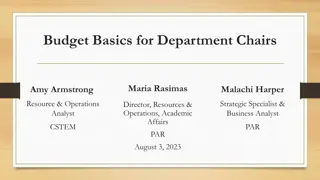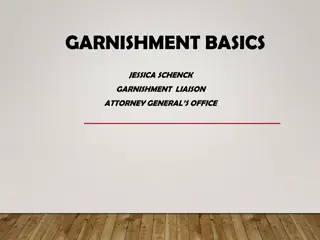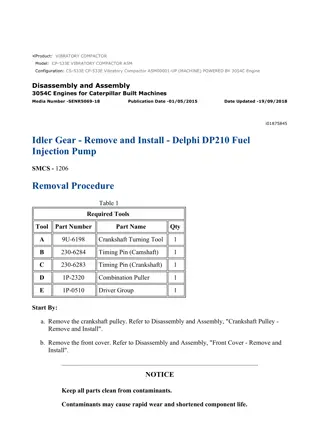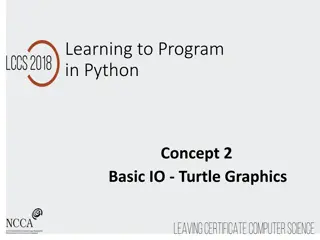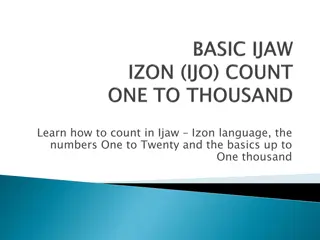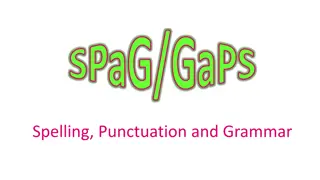IT Basics ASM - 2
In assembly language programming, conditional jumps and flags play a crucial role in controlling program flow based on specific conditions. Flags provide information about previous instructions, enabling the transfer of program execution to different locations within the program. This includes setting flags such as sign (S), zero (Z), carry (C), parity (P), and overflow (O) to make decisions using conditional jumps. Numerical comparisons, like CMP and SUB instructions, are used to compare values and compute differences, updating flags accordingly. Understanding flag settings is essential for comparing signed integers and implementing jump instructions based on the sign and overflow flags.
Download Presentation

Please find below an Image/Link to download the presentation.
The content on the website is provided AS IS for your information and personal use only. It may not be sold, licensed, or shared on other websites without obtaining consent from the author.If you encounter any issues during the download, it is possible that the publisher has removed the file from their server.
You are allowed to download the files provided on this website for personal or commercial use, subject to the condition that they are used lawfully. All files are the property of their respective owners.
The content on the website is provided AS IS for your information and personal use only. It may not be sold, licensed, or shared on other websites without obtaining consent from the author.
E N D
Presentation Transcript
IT Basics ASM - 2 R zvan Daniel ZOTA Faculty of Cybernetics, Statistics and Economic Informatics zota@ase.ro https://zota.ase.ro/itb
Contents Jump & program control instructions 2
Conditional jumps Logic and arithmetic instructions are setting the flags The flags are offering information about the previous instructions Using flags we may transfer (using a conditional jump) the program execution to another instruction inside the program if the condition was true Jump to the specified location Instruction Pointer (IP) modifies continuously (to point to the next instruction to be executed) if the condition was false Program is continuing its execution with the next instruction IP is incremented as usual 3
Conditional jumps(cont.) The conditional jumps are testing: sign (S), zero (Z), carry (C), parity (P) and overflow (O) Obs.: Val. FFh is greater than 00h for unsigned numbers Val. FFh (-1) is less than 00h for signed numbers Comparison: unsigned ffh greater than 00h but signed ffh less than 00h 4
Numerical comparisons CMP X,Y(compare) compares two values X and Y Like a subtraction that modifies only the flags Used to check the contents of a register or a memory location with another value Usually it is used with a conditional jump CMP AL, 10h ;compares AL with10h (AL doesn t change) JAE SUPER ;if 10h >= then jump to label SUPER SUB X,Y(subtraction) computes the difference X - Y Saves the result in X and sets the flags 5
Flags settings CMP Op1, Op2 Unsigned operands Signed operands Z: eq/not-eq Z: eq/not-eq C: Op1 < Op2 (C=1) Op1 >= Op2 (C=0) C: no meaning S: no meaning O: no meaning S and O together If ((S=0) and (O=1)) or ((S=1) and (O=0)) then Op1 < Op2 If ((S=0) and (O=0)) or ((S=1) and (O=1)) then Op1 >= Op2 6
Comparing signed integers Let s consider: CMP AX,BX The Sign bit (S) will be set function of the result for the operation AX-BX (if it has an 1 in the msb of the result) The Overflow flag (O) will be set if the result AX-BX represents a number outside the definition range (-32768 to 32767 for 16-bits) represented as an integer. Instructions JS (jump on sign) and JL (jump less than) JS looks at sign bit (S) for the last comparison or subtraction. S = = 1 then the jump is done. If JL verifies the last comparison 7
Comparing signed integers (cont.) JL is true if: S=1, O=0: (AX-BX) negative and (AX-BX) did not produce overflow Example (8-bits): (-5) - (2) = (-7) The result (-7) has the sign bit set In this case (-5) is less than (2). 8
Jump instructions terminology The terminology used for the jump instructions is the following: Above/Below used for unsigned comparison Greater/Less used for signed comparison Names significance: J => Jump N => Not A/B G/L => Above/Below Greater/Less E => Equal 9
Jump instructions summary Instruction Description Conditions JA=JNBE JBE=JNA JAE=JNB=JNC Jump if above Jump if not below or equal Jump if below or equal C=1 | Z=1 Jump if above or equal C=0 & Z=0 C=0 Jump if not below Jump if no carry Jump if below Jump if carry JB=JNA=JC C=1 JNE=JNZ JS JE=JZ Jump if equal Jump if Zero Jump if not equal Jump if not zero Jump Sign (MSB=1) S=1 Z=1 Z=0 10
Jump instructions summary (cont.) Instruction Description Conditions JNS Jump Not Sign (MSB=0) S=0 JO Jump if overflow set O=1 JNO Jump if no overflow O=0 JG=JNLE Jump if greater Jump if not less or equal S=O & Z=0 JGE=JNL Jump if greater or equal S=O Jump if not less JL=JNGE Jump if less Jump if not greater or equal JLE=JNG Jump if less or equal Jump if not greater JCXZ Jump if register CX=zero CX=0 11
The LOOP instruction LOOP instruction A combination of decrementing CX with a conditional jump LOOP is decrementing CX (ECX for 32-bit) and if CX 0 it jumps to the specified label When CX is 0, the next instruction is executed 12
LOOP instruction - example .model small .data mesaj db 13,10, Happy New Year 2025!$ .stack 100h .code Pstart: mov ax,@data mov ds,ax mov dx, offset mesaj ; loading the address of the string mov CX,05 Again: mov ah,09 ;DOS function code to display a string int 21H LOOP Again mov ah, 4Ch int 21h end Pstart 13












